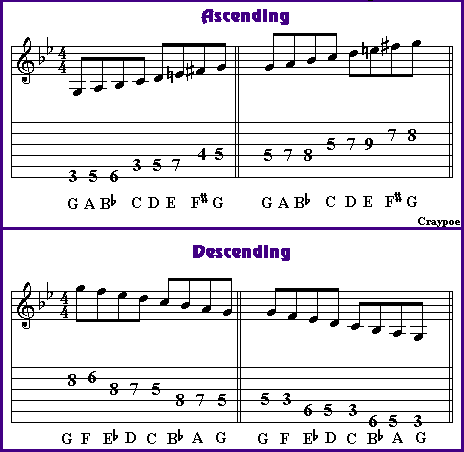

Compare the differences in the others: For example, A harmonic minor contains a Bdim chord, while A melodic minor has Bm. Note that the A harmonic and melodic minor scales share four of the same triads-Am, Caug, E, and G#dim. Now play the A melodic minor scale’s triads, first as block chords ( Example 7) and then in arpeggios ( Example 8). Example 6 contains the same triads, but played as eighth-note triplets, for a good fretboard workout. The point of this exercise is so that you can see how the chords are built and get accustomed to their sounds. If you struggle to play these chords-in particular, the Bdim on the “and” of beat one requires a pretty big stretch of the fretting fingers-don’t worry. You can do this by stacking two thirds from within the scale on top of each note, as shown in Example 5. This week you’ll start expressing the A harmonic and melodic minor scales in triads, all using closed voicings.
#Melodic minor scales guitar free#
After you’ve worked through this week’s examples, if you have a good knowledge of the fretboard, try playing the scales and harmonized thirds in other positions as well, and feel free to transpose them-for instance, just move everything up two frets to play the B harmonic and melodic minor scales, three frets for C harmonic and melodic minor, and so on.Īfter you’ve learned the A harmonic and melodic minor scales, try playing them in other keys as well. Though the A harmonic and melodic minor scales share all but one note in common, they impart noticeably different moods. Repeat the same ideas with the ascending A melodic minor scale, as shown in Examples 3–4. Then, as a precursor to playing chords from within the A harmonic minor scale, try Example 2, in which the scale is harmonized in thirds-again, slowly so that you can really get a feel for things. Use whatever fingerings feel most natural to you. Play this slowly and repeatedly, until you get accustomed to the way it sounds and feels. In this lesson, we’ll be focusing only on the ascending form of the melodic minor scale.Įxample 1 shows the A harmonic minor scale played in two octaves, starting on the fifth-fret A. Both the sixth and seventh are raised in the ascending form of A melodic minor (A B C D E F# G#), but in the descending form, those two notes are lowered (i.e., identical to the natural minor scale). The A harmonic minor scale (A B C D E F G#) is the same, except the seventh is raised, lending a somewhat mysterious character. To understand how the harmonic and melodic minor scales are constructed, first take the A natural minor scale (A B C D E F G).
#Melodic minor scales guitar series#
Weekly Workout is a series of monthly guitar exercises made up of interesting technical workouts that will get your fretting- and picking-hand fingers working in different ways, and offer musical studies that will help you visualize and explore the fingerboard. As you work through this lesson, keep in mind that the goal is to get these complex chords in your ears and under your fingers, so that they’ll be available whenever you compose or improvise. These materials can provide not only interesting fretboard exercises but abundant color for your guitar arsenal. For a higher level of sophistication, in this advanced lesson I’ll introduce you to the melodic and harmonic minor scales and the harmonies that can be generated from them. Many acoustic guitarists spend the bulk of their time with the major and natural minor scales and their associated chords-the harmonic basis of so many popular styles, from folk to country to rock.

From the March/April 2021 issue of Acoustic Guitar | By Ron Jackson


 0 kommentar(er)
0 kommentar(er)
